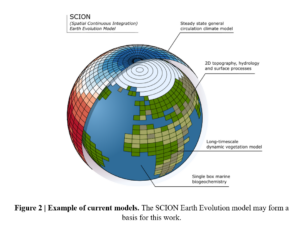How did solid Earth processes influence the accumulation of oxygen in our planet’s atmosphere?
How did solid Earth processes influence the accumulation of oxygen in our planet’s atmosphere?
Benjamin Mills (Leeds), Chris Davies (Leeds), Ravi Kopparapu (NASA), Weijia Kuang (NASA), Joshua Krissansen-Totton (University of Washington)
Project Summary
The Earth’s atmosphere has become rich in oxygen over its 4.5-billion-year history, and this allows it to support complex and intelligent lifeforms. We know that the source of this oxygen is through photosynthesis, but it took billions of years after the evolution of photosynthesis for oxygen to rise to the present 21% of the atmosphere. Therefore, the rise of oxygen is likely to be reliant on continued recycling of material through plate tectonics, the build-up of carbon and other bio-essential elements in the crust, and Earth’s magnetic field and its ability to prevent atmospheric erosion by the charged particles that form the solar wind.

Only recently have ‘Earth System’ computer models become available which are able to test these ideas by reconstructing Earth’s oxygenation over time, as well as outputting estimates for key elemental and isotopic ratios for model validation. But these models are still very new, and do not contain any realistic representations of deep Earth processes. For example, current model heat fluxes and spreading rates follow a simple exponential decay, crustal composition is not calculated from the other model processes, and the magnetic field is not included at all. In this project, the researcher will work towards the next generation of models for Earth’s oxygenation, specifically aiming to better incorporate solid Earth processes and their effect on oxygen rise.
The project will begin from our recent model, and the researcher will add new model processes and external forcings – based on the state of the art across the field – in order to answer key questions about our planet’s history:
- Did variation in spreading rates drive pulsed oxygenation that coincides with major biological radiations?
- Did the Earth’s crust gradually become carbon-rich or did this occur in steps?
- What was the contribution of the magnetic field to oxygenation and do strong fields allow for higher oxygen levels?

Working environment
The research will be based in the Earth Evolution Modelling Group, which is a large, well-funded and active research group of about 20 people, within the Earth Surface Science Institute (ESSI), itself within the School of Earth and Environment at the University of Leeds. ESSI is a friendly research institute that includes analytical geochemists, biogeochemists, sedimentologists, palaeontologists and modellers of climate and biogeochemistry. The institute holds several annual science and social events and weekly informal get-togethers. Project supervisor Mills has received multiple ESSI ‘Star Supervisor’ awards.
Entry requirements
This project would suit somebody with a degree in one of the natural sciences, mathematics or computing, and the candidate should have a strong interest in Earth history and planetary surface environments. Formal training in numerical techniques is not essential, but enthusiasm for computing is advisable. All necessary training will be provided as part of the project. The group writes mostly in MATLAB and occasionally in python, but the researcher would be supported to apply a programming language of their choice.
Further information
Professor Mills can be reached at b.mills@leeds.ac.uk for any questions about this project. See https://EarthEvolutionModelling.com for more information about the Earth Evolution Modelling Group.
